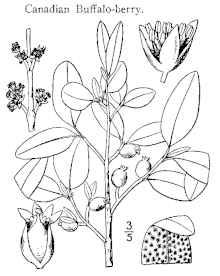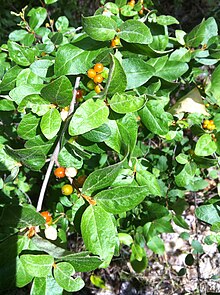Canadian Buffalo Berry
| Canadian Buffalo Berry | ||||||||||||
|---|---|---|---|---|---|---|---|---|---|---|---|---|

Canadian Buffalo Berry ( Shepherdia canadensis ) |
||||||||||||
| Systematics | ||||||||||||
|
||||||||||||
| Scientific name | ||||||||||||
| Shepherdia canadensis | ||||||||||||
| Nutt. |

The Canadian buffaloberry ( Shepherdia canadensis ) is one of the three species that belongs to the genus of buffaloberries . The Canadian buffaloberry is a shrub found in open, sparse forests and bushland in North America. The shrub is common in Alaska. The Canadian buffalo berries reach a height of one to four meters. It bears small, lonely red berries. Humans perceive the taste of these berries as bitter.
description
The Canadian buffalo berry is a deciduous shrub that reaches heights of one to four meters. The thin branches are covered with reddish-brown scales. As with the other buffalo berries, the roots have thickenings with nodule bacteria ( Frankia ) that can fix nitrogen. The oppositely arranged leaves are light green above, paler below with conspicuous brown scales.
The flowering period extends from April to June. The flowers are either male or female, with only one form occurring on a plant ( diocyte ), plants with male and female flowers are rare. The flower develops into a berry-like fruit, with the pulp being formed by the flower cup that encloses a nut fruit . The round fruits are orange or red, there is a shape with yellow fruits ( Shepherdia canadensis forma xanthocarpa Rehd. ). The fruits ripen from June to August.
The number of chromosomes is 2n = 22.
distribution
The Canadian buffalo berry has a large distribution area in northern North America. In the north it occurs in Canada and Alaska to the north of the Arctic Circle. To the southeast, the US-Canadian border is roughly its southern distribution limit, but to the southwest it occurs much further south in the higher elevations of the Rocky Mountains and reaches Arizona and New Mexico . Altitudes up to 3400 meters are settled.
The Canadian buffalo berries are found in the undergrowth of sparse coniferous forests, such as the rocky mountain fir ( Abies lasiocarpa ), yellow pine ( Pinus ponderosa ), white spruce ( Picea glauca ), Douglas fir ( Pseudotsuga menziesii ), coastal pine ( Pinus contorta) ), Engelmann spruce ( Picea engelmannii ), and in forest communities with American quivering poplars ( Populus tremuloides ). The soils on which this buffalo berry grows are mostly skeletal and range from sandy to gravel to rocky. The Canadian buffaloberry can colonize poorly nutrient-poor soils, where it forms many root nodules in order to collect nitrogen.
ecology
The leaves are eaten by mule deer , white-tailed deer and elk . Bighorn sheep mainly use the fresh shoot. Domestic animals such as cattle and horses tend to disdain the Canadian buffalo berries. Buffaloberries are also food for some butterflies , such as Coleophora elaeagnisella .
The fruit is often eaten by bears. In the Yukon, the Canadian buffalo berry is the most important fruit in the grizzly bear diet . Based on grizzly bear droppings, it has been estimated that individual individuals eat up to 200,000 fruits a day. They play an essential role in the time when the bears build up their fat stores for wintering. Even black bear and grouse eat the fruit.
After a fire, the Canadian buffalo berries emerge from the rhizome again. It can withstand fire well and benefits from the thinned canopy.
use
The fruits of the Canadian buffalo berries played a role in the diet of the indigenous peoples who gathered in what is now Canada. The use of these fruits is mainly passed down by the Nlaka'pamux and the Secwepemc , who settled in what is now British Columbia . The bitter berries were not eaten directly, but made into sxusem . The berries were mixed with sweet fruits and the crushed mixture of berries was strongly beaten to create the typical foam of the Sxusem dish. The foam is created due to the saponins contained in the buffaloberries . Ingested in large quantities, such saponins can cause stomach irritation in humans. The indigenous peoples, with whom Sxusem played a role, attributed health-promoting properties to the mixture. The taste of Sxusem is bittersweet - not unlike a sweetened coffee.
Due to the saponin content, the berries can also be used as a natural soap, which is why the plant is also known as a soapberry in English (not to be confused with plants of the genus Sapindus, which are also known in English as soapberries).
A medicinal brew was made from various parts of the plant by boiling them.
The Canadian buffalo berry can be used to re-green disturbed areas and prevent erosion. Horticultural propagation is possible via root cuttings, the plants also grow well on raw soil and improve the fertility of the soil through their ability to collect nitrogen. The Canadian buffalo berry is occasionally used as an ornamental wood.
supporting documents
- Crystal J. Walkup (1991): Shepherdia canadensis . In: Fire Effects Information System, (Online). US Department of Agriculture, Forest Service, Rocky Mountain Research Station, Fire Sciences Laboratory.
- Scott C. Walker: Shepherdia Nutt .: Buffaloberry . Archived from the original on July 17, 2011. Retrieved January 7, 2011.
- Soopoly (Shepherdia canadensis). (PDF; 45 kB) Ministry of Forests and Range, British Columbia, accessed on August 13, 2009 .
Single receipts
- ^ Shepherdia canadensis at Tropicos.org. In: IPCN Chromosome Reports . Missouri Botanical Garden, St. Louis
- ^ Thomas S. Elias: Edible Wild Plants A North American Field Guide (Digitized online by Google books), Cengage Learning, 1983, ISBN 0-442-22254-8 , pp. 9-28, 258 (accessed January 25, 2009 ). .
- ^ Stephen Herrero: Bears - Hunters and Hunted in America's Wilderness , Müller Rüschlikon Verlag, Cham 1992, ISBN 3-275-01030-1 , p. 216
- ↑ https://www.youtube.com/watch?v=WtQKUj9Sj1s
